
Student Research Showcase
Empowering the Next Generation of Innovators!

Empowering the Next Generation of Innovators!
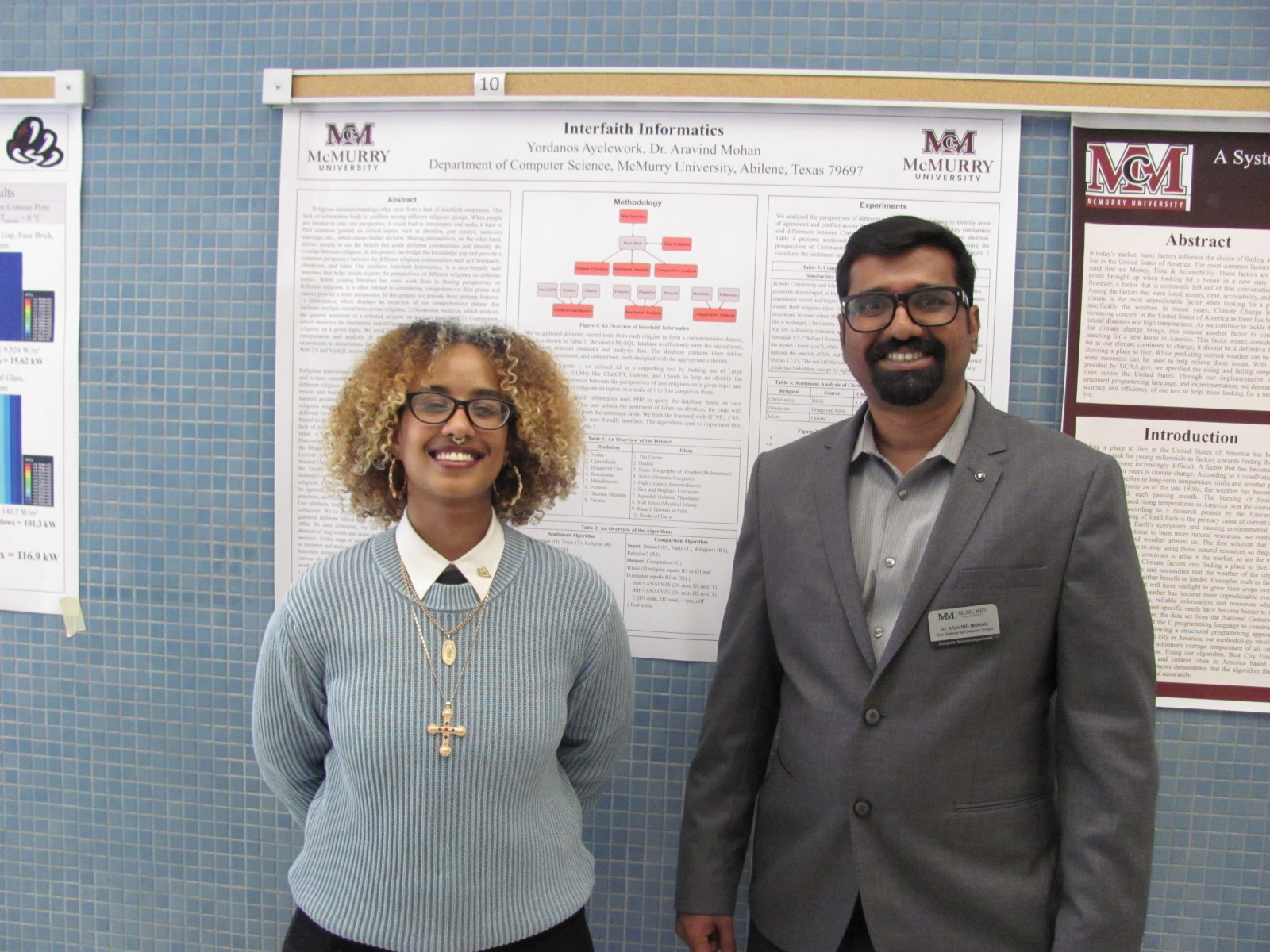
Venue: Texas Academy of Science 2025
Religious misunderstandings often stem from a lack of interfaith awareness. This lack of information leads to conflicts among different religious groups. When people are limited to only one perspective, it could lead to stereotypes and make it hard to find common ground on critical topics; such as abortion, gun control, same-sex marriage, etc., which causes further division. Sharing perspectives, on the other hand, allows people to see the beliefs that guide different communities and identify the overlap between religions. In this project, we bridge the knowledge gap and provide a common perspective between the different religious communities such as Christianity, Hinduism, and Islam. Our platform, Interfaith Informatics, is a user-friendly web interface that helps people explore the perspectives of different religions on different topics. While existing literature has some work done in sharing perspectives on different religions, it is often limited in considering comprehensive data points and cannot provide a better perspective. In this project, we provide three primary features: 1) Information, which displays an overview of our comprehensive dataset that includes multiple sacred texts across religions; 2) Sentiment Analysis, which analyzes the general sentiment of a selected religion on a given topic; and 3) Comparison, which identifies the similarities and differences of the perspectives from two selected religions on a given topic. We used generative AI as a supporting resource for the interpretation and analysis of sacred texts. Finally, we conducted preliminary experiments to demonstrate the efficiency of our tool, which is developed using Web 2.0 and MySQL technology.
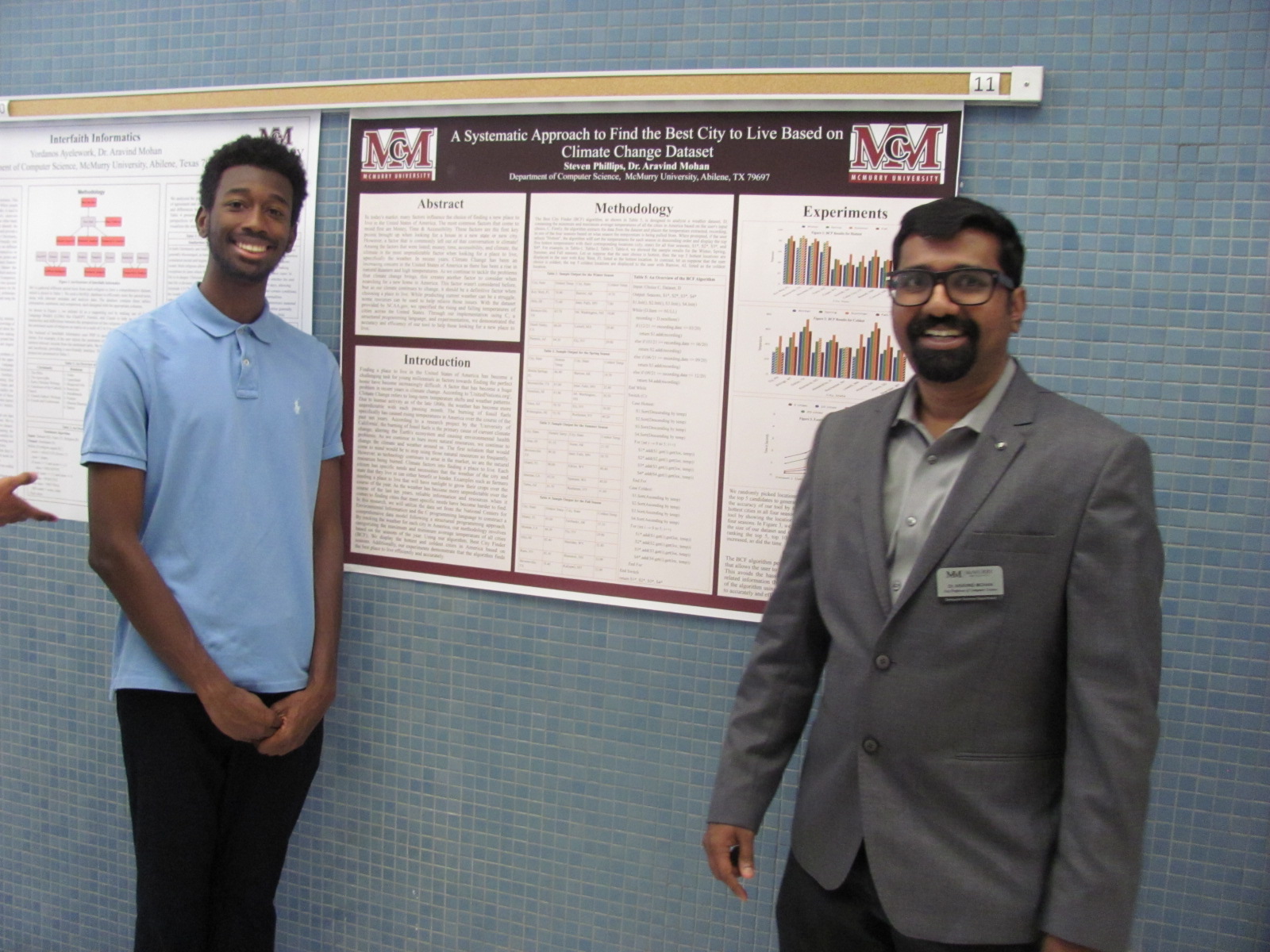
Venue: McMurry Research Symposium 2025
In today's market, many factors influence the choice of finding a new place to live in the United States of America. The most common factors that come to mind first are Money, Time & Accessibility. These factors are the first key points brought up when looking for a house in a new state or new city. However, a factor that is commonly left out of that conversation is climate! Among the factors that were listed; money, time, accessibility, and climate, the climate is the most unpredictable factor when looking for a place to live, specifically the weather. In recent years, Climate Change has been an increasing concern in the United States of America as there has been a rise in natural disasters and high temperatures. As we continue to tackle the problems that climate change brings, this creates another factor to consider when searching for a new home in America. This factor wasn't considered before, but as our climate continues to change, it should be a definitive factor when choosing a place to live. While predicting current weather can be a struggle, some resources can be used to help relieve those issues. With the dataset provided by NCAA.gov, we specified the rising and falling temperatures of cities across the United States. Through our implementation using C, a structured programming language, and experimentation, we demonstrated the accuracy and efficiency of our tool to help those looking for a new place to live.
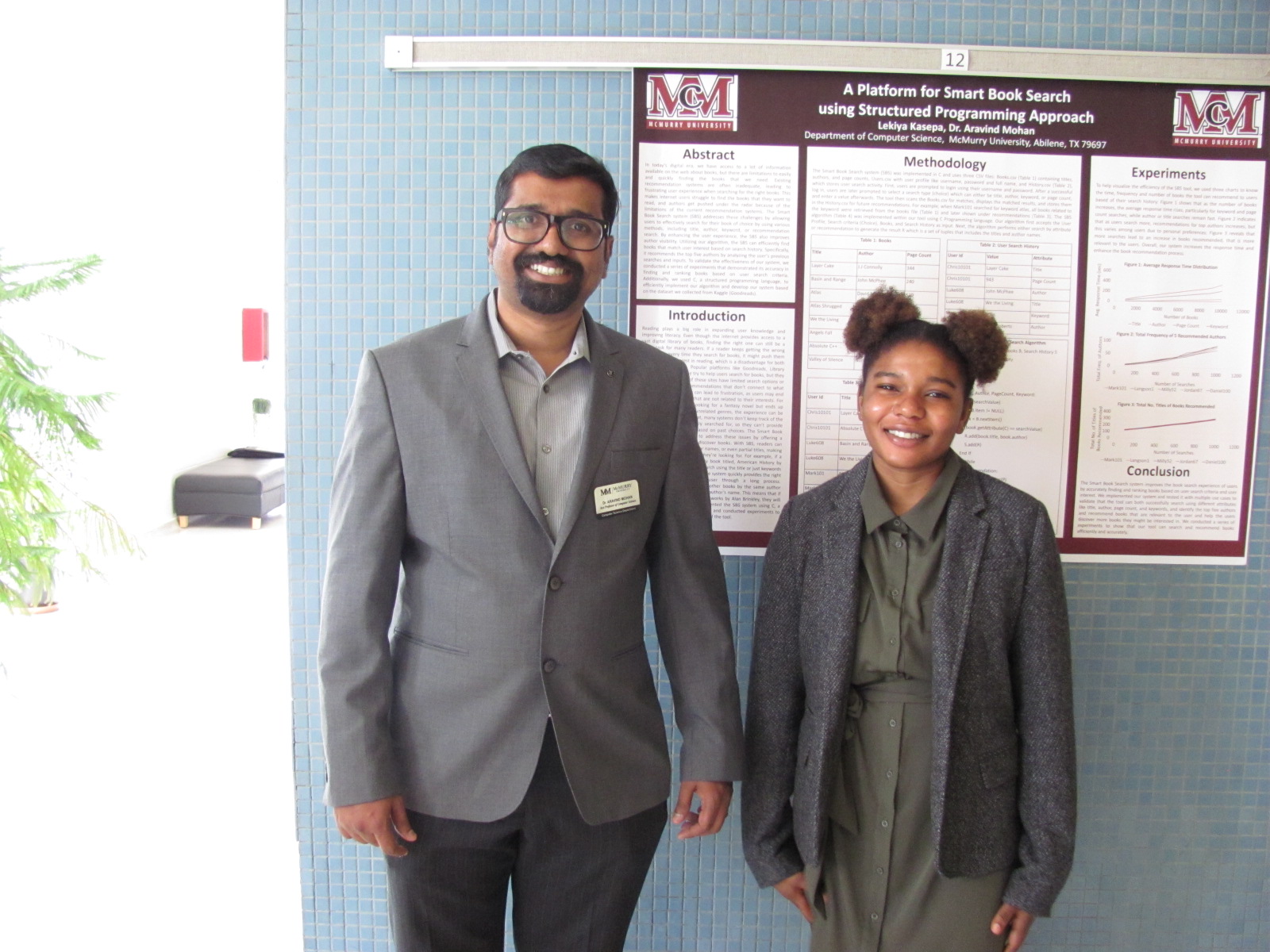
Venue: Abilene Christian University Research Symposium 2025
In today's digital era, we have access to a lot of information available on the web about books, but there are limitations to easily and quickly finding the books that we need. Existing recommendation systems are often inadequate, leading to frustrating user experience when searching for the right books. This makes internet users struggle to find the books that they want to read, and authors get pushed under the radar because of the limitations of the current recommendation systems. The Smart Book Search system (SBS) addresses these challenges by allowing users to effectively search for their book of choice by using various methods, including title, author, keyword, or recommendation search. By enhancing the user experience, the SBS also improves author visibility. Utilizing our algorithm, the SBS can efficiently find books that match user interest based on search history. Specifically, it recommends the top five authors by analyzing the user's previous searches and inputs. To validate the effectiveness of our system, we conducted a series of experiments that demonstrated its accuracy in finding and ranking books based on user search criteria. Additionally, we used C, a structured programming language, to efficiently implement our algorithm and develop our system based on the dataset we collected from Kaggle (Goodreads).
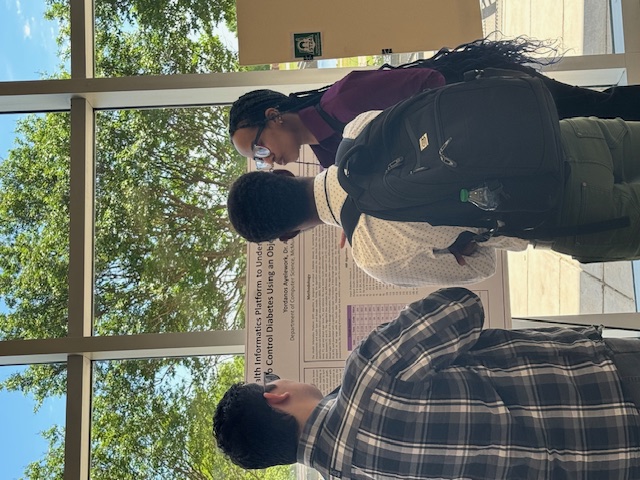
Venue: Abilene Christian University Research Symposium 2024
Insulin Dependent Diabetes Mellitus (IDDM), commonly known as Type 1 Diabetes, is a chronic and critical condition that occurs when the pancreas produces little to no insulin, resulting in elevated blood sugar levels (hyperglycemia), which can in turn cause blindness, kidney failure, heart disease, and even death. Consequently, the treatment of IDDM is mainly concerned with administering insulin to lower the blood sugar level to as close as possible to normal. The goal of this research is to identify the level of impact that the administration of different types of insulin and the dosage units has on blood sugar levels and how it can help manage diabetes. This research extracts real-world Multivariate, Time-Series Diabetes patients’ dataset from the publicly available UC Irvine Machine Learning Repository. We implemented our data model and algorithm using Java programming language in an object-oriented approach and grouped the blood sugar levels into different impact groups such as low, normal, and high, assuming typical meal ingestion and exercise levels. The preliminary experiments conducted using our tool are helpful to understand the impact of insulin types and dosage units to control diabetes.

Venue: Abilene Christian University Research Symposium 2024
In the big data era, social media platforms like YouTube have emerged as massive repositories of information and opinions, reflecting the diverse voices and perspectives of users worldwide. Amidst this wealth of data, understanding user sentiment becomes paramount for organizations and individuals alike, serving as a compass for navigating the digital landscape and informing strategic decision-making processes. By discerning the prevailing sentiments expressed within the vast array of social media content, stakeholders can refine content strategies, tailor marketing approaches, and anticipate trends with greater accuracy. Addressing the challenge of extracting valuable insights from public opinions shared through social media platforms presents a multifaceted research endeavor. At the forefront of this inquiry lies the critical question of how to effectively harness the power of social media data to gain actionable insights. One promising avenue for exploration involves connecting topics to YouTube videos and conducting sentiment analysis on the accompanying comments. By categorizing sentiments as positive and negative, researchers can capture the prevailing public opinion on distinct topics and themes discussed in YouTube videos, providing a better understanding of audience perceptions and preferences. This entails extracting specific comments on topics of interest, ensuring a targeted and focused analysis. Using advanced natural language processing (NLP) techniques implemented in the Java programming language. By advancing our understanding of user sentiment on social media platforms like YouTube, this research aims to empower individuals andorganizations with actionable insights for informed decision-making and strategic planning. We can unlock the full potential of social media data as a valuable resource for understanding human behavior, societal trends, and consumer preferences in the digital age.
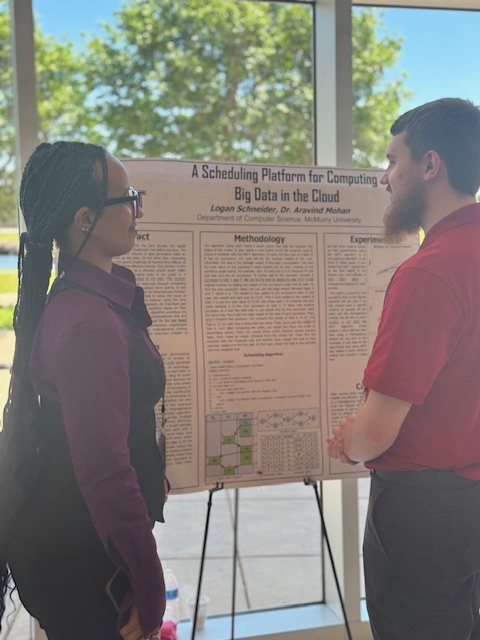
Venue: Abilene Christian University Research Symposium 2024
The era of big data has started. Over the past decade, the digital revolution has resulted in three major challenges that define big data. The large volume, variety of types, and velocity of data generation make an arbitrary dataset be classified as big data. On the other side, computing big data is presented with the grand challenge of transforming billions of bits and bytes into insights in a time-effective manner. One solution to this problem is to represent computation as a directed acyclic graph called workflow and use the cloud for allocating tasks in the graph to a computational resource that is more suited to the task. This solution allows the effective use of computational resources through scheduling and provides a framework for data to be processed more quickly. In this research, a popular scheduling algorithm known as Heterogenous Earliest-Finish-Time (HEFT) algorithm was implemented to solve the issue of computing big data in a usable and scalable manner using the Java programming language in an object-oriented approach. An important part of this algorithm is to rank the tasks in the workflow based on their computational and data transfer time. The HEFT algorithm prioritizes the task with the highest upward rank value at each computational step and applies a series of rules to identify the best processor for the task based on their computational and transfer time. The preliminary experiments conducted in this research are instrumental in understanding existing research and thinking of new ways to solve the important problem of computing big data effectively in the future.